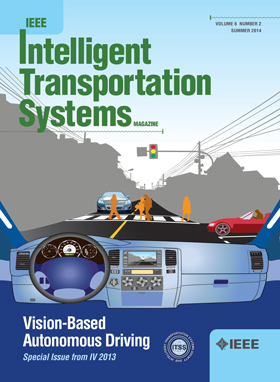鲁棒协同自适应巡航控制系统设计:寄生驱动滞后与通信延迟的权衡
IF 8.4
1区 工程技术
Q1 ENGINEERING, CIVIL
IEEE Transactions on Intelligent Transportation Systems
Pub Date : 2025-04-18
DOI:10.1109/TITS.2025.3553812
引用次数: 0
摘要
在本文中,我们提供了一个系统的程序来设计协作自适应巡航控制(CACC)系统,该系统对制动和推进的寄生驱动滞后以及来自前代车辆的通信加速度延迟具有鲁棒性。特别地,我们导出了CACC系统中可使用时距的紧下界,以保证串的鲁棒稳定性。车头时距的下界取决于寄生驱动滞后($\tau _{0}$)和通信延迟($\ well $)的上界。本文的主要结果是,如果$\tau _{0}$超过$\ well $,则可雇用时距下界为$\tau _{0}+\ well $。否则,最好使用自适应巡航控制(ACC),其中可使用时距下界为$2\tau _{0}$。在CACC系统上的上述结果随后扩展到下一代CACC (CACC+)系统,该系统使用来自多个前代车辆的信息。对某典型机动进行的数值模拟验证了主要结果。本文章由计算机程序翻译,如有差异,请以英文原文为准。
Robust Cooperative Adaptive Cruise Control System Design: Trade-Off Between Parasitic Actuation Lag and Communication Delay
In this paper, we provide a systematic procedure for designing cooperative adaptive cruise control (CACC) systems that are robust to parasitic actuation lag in braking and propulsion and delay in the communicated acceleration from the predecessor vehicle. In particular, we derive a tight lower bound on the employable time headway in CACC systems for guaranteeing robust string stability. The lower bound on the time headway is dependent on the upper bound on the parasitic actuation lag ( $\tau _{0}$ ) and the communication delay ( $\ell $ ). The main result of the paper is that if $\tau _{0}$ exceeds $\ell $ , then the employable time headway is lower bounded by $\tau _{0}+\ell $ . Otherwise, it is better to use adaptive cruise control (ACC) where the employable time headway is lower bounded by $2\tau _{0}$ . The above results on CACC systems are then extended to next-generation CACC (CACC+) systems that employ information from multiple predecessor vehicles. Several comparative numerical simulations for a representative maneuver corroborate the main results.
求助全文
通过发布文献求助,成功后即可免费获取论文全文。
去求助
来源期刊

IEEE Transactions on Intelligent Transportation Systems
工程技术-工程:电子与电气
CiteScore
14.80
自引率
12.90%
发文量
1872
审稿时长
7.5 months
期刊介绍:
The theoretical, experimental and operational aspects of electrical and electronics engineering and information technologies as applied to Intelligent Transportation Systems (ITS). Intelligent Transportation Systems are defined as those systems utilizing synergistic technologies and systems engineering concepts to develop and improve transportation systems of all kinds. The scope of this interdisciplinary activity includes the promotion, consolidation and coordination of ITS technical activities among IEEE entities, and providing a focus for cooperative activities, both internally and externally.
 求助内容:
求助内容: 应助结果提醒方式:
应助结果提醒方式:


